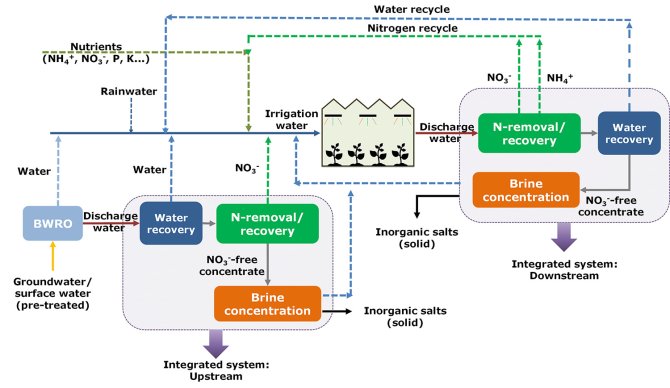
Project
Recyle of Water & Recovery of Dissolved Nitrogen in Greenhouse Horticulture - Closing Water and Nitrate Cycles Towards Zero Liquid Discharge
The Dutch government (municipalities and water boards) and growers have united to develop strategies aimed at reducing the emission of nutrients and crop protection products from horticulture into soil and water, thereby mitigating adverse environmental effects. Their collective goal is to achieve zero nutrient discharge by 2027. To realise this objective, they recognise the need to implement sustainable solutions to increase water reuse, remove components from discharge water, and potentially recover them for reuse.
In the Netherlands, greenhouse systems typically feature two water drainage points: one before (upstream) and one after (downstream) irrigation. The initial discharge point occurs after groundwater desalination for irrigation purposes, often through reverse osmosis. This process yields a low-salinity stream for irrigation and a concentrated stream (concentrate) that requires disposal. Traditionally, rejected concentrates are infiltrated back into the ground, but this practice may negatively impact soil salinity (total dissolved solids), which will only be permissible via customisation post-2022. Local authorities seek more sustainable alternatives.

Following irrigation, drain water is typically recycled. However, prolonged recycling can elevate the sodium content of the water, necessitating downstream discharge to prevent adverse effects on plant growth due to high sodium concentrations.
The project aims to identify, evaluate, and further develop sustainable technical solutions for treating concentrated water flows—containing high concentrations of salts (sodium and chloride), nutrients, and other components—generated in greenhouse horticulture. The project also strives to maximise water and nitrate use and recovery, ultimately aiming for Zero Liquid Discharge.
Government institutions, the greenhouse horticulture sector, water technology providers, and knowledge institutions collaborate on-site to demonstrate the potential application of integrated systems. These systems comprise state-of-the-art technology units for water, nitrate, and concentrate treatment, as well as for the recovery of valuable components from discharge water. Ultimately, the project seeks to offer practical guidance on minimising discharges of aqueous flows from greenhouses.